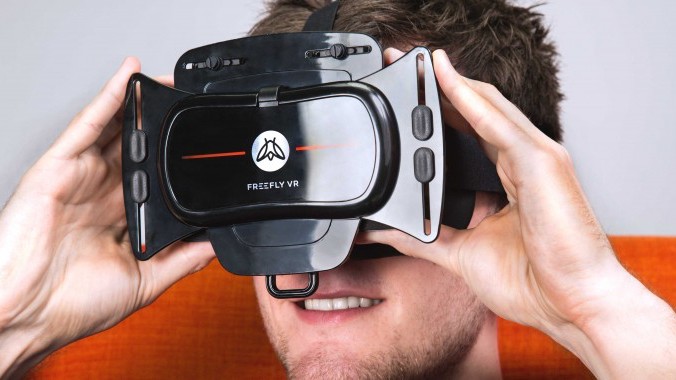Top 11 Best Virtual Reality Headsets in The World
Virtual reality, the word works like magic when we hear it. This concept takes us to the endless possibilities, where we want to go we can by virtual reality and feel that place the right front of our eyes. We can say virtual reality is one of the best inventions of ever made by human being. Now in 2016 is the start line of the virtual reality open to all to play ad feel it. Virtual Reality Headsets, let’s check them out.
So here you’ll find one of the Top 11 best virtual reality headsets in the world. So lets check this out.
HTC Vive
The HTC Vive, is the Steam VR headset made in collaboration with Valve, the makers of legendary gaming series Half Life, and it hited shops in April.

The HTC Vive plugs into PCs and work with Valve’s mammoth gaming ecosystem. It packs in 70 sensors to offer 360 degree head-tracking as well as a 90Hz refresh rate.
Essential reading: Top 6 Advantages of Virtual Reality
However, the key to the HTC Vive’s success is the Lighthouse room tracking that enables you to move around with the headset on.
Out now, $799, htcvive.com
Oculus Rift

Oculus Rift is Developed by Palmer Luckey, funded via Kickstarter and snapped up by Facebook for a cool $2 billion, the Rift plugs into your computer’s DVI and USB ports and tracks your head movements to provide 3D imagery on its stereo screens.
The consumer edition Rift uses a 2160 x 1200 resolution, working at 233 million pixels per second, with a 90Hz refresh rate. It’s high tech stuff, which matches the HTC Vive for refresh rate, but lags behind PlayStation VR. However, given its access to the power of latest PCs, it will be pushing a lot more pixels than Sony’s headset.
Essential reading: Virtual reality , Oculus Rift , Oculus VR
Out now, $599, oculus.com
Sony PlayStation VR

PlayStation VR is ready to launch on : 13 October 2016 in the whole world. Sony is making it best of the best VR headset that why it took some time.
A 5.7-inch OLED one which enables low persistence, which should mean less motion blur. The display’s refresh rate has also been ramped up to 120Hz, making 120fps gaming a real possibility.
The reported latency issues of Morpheus Mk1 have been addressed, with a new 18ms reading, and tracking accuracy has been tweaked with a total of nine LEDs now aiding the positional awareness of the headset.
Essential reading: Video Games, Released in August 2016
Out 13 October 2016 $399, sony.com
Samsung Gear VR

The Samsung Gear VR is lite version of oculus rift, given that the two companies collaborated for the technology.
The Gear VR is simply a case that uses a Samsung Galaxy smartphone as its processor and display. The handset simply slots in front of the lenses, into a Micro USB dock, and uses its Super AMOLED display as your screen. Slot in the phone, stick on the headset and you’re into your virtual reality experience. you must use a Samsung handset for using this.
Check them out: Samsung Company Announces to Open a Virtual Reality Studio in New York City
$99, samsung.com
Google Cardboard

Google announced its Cardboard virtual reality headset at I/O 2014 and unveiled version 2 at the 2015 conference. Popping a smartphone into a cardboard container and then strapping it to your head and it works, and it could become a low-cost way to experience virtual reality.
After all, your smartphone contains all the necessary gyroscopic sensors and positioning systems to accurately track your head movements. Related is Durovis’ Dive, which is essentially the same thing made of higher quality and more sweat-resistant materials.
With the popularity of Cardboard, Google decided it would release an even better one. Called Daydream, the device is pretty much a Gear VR but apparently there’s a whole slew of Android phones getting revamped to provide a better VR experience with Daydream. Companies making the handsets will also likely release their own mobile headsets.
There’s no official date for its release except an estimate for this fall. We’ll update the list to see if the Google VR headset – or any others running the Daydream platform – makes the cut then.
Take a look at the Top Disadvantages of Virtual Reality.
$16.99
Microsoft HoloLens

Microsoft HoloLens, blends virtual and half augmented reality to make one of the most ambitious launches ever planned. The device merges real-world elements with virtual ‘holographic’ images, meaning you can look at your Minecraft world on your kitchen table, or walk around the surface of Mars in your living room.
Using Kinect-style tech to recognise gestures and voice commands, the headset has a 120-degree field of vision on both axes, and is capable of ‘high definition’ visuals, but it’s still a letterbox compared to the likes of Oculus and Valve. More importantly, however, there’s no connection to a PC – a full Windows 10 system is built into the headset and runs off a battery. No, we can’t wait to see how long that lasts either.
The Development Edition is available now for Windows Insider members with a price tag of $3,000.
$3,000, microsoft.com
Meta 2

Meta had a developer kit of its augmented reality headset in 2013 but it’s theMeta 2 that’s caught our attention. It looks similar to HoloLens with its large shape and helmet-like design.
At 90 degrees, it’s three times bigger than the original Meta, and its 2560 x 1440 display plus positional tracking allowing your hands to interact with what you see makes for a very promising device.
$949, metavision.com
Razer OSVR HDK 2

Razer’s OSVR isn’t a rival to the likes of Oculus Rift, PlayStation VR, and Samsung Gear VR. There’s even a newer headset out aptly called the OSVR Hacker Developer Kit 2. It’s got better hardware specs, this time, around with 2160 x 1200 dual OLED display putting it right up against the big names. However, there’s still some comfort issues to work through.
HDK 2 $399, HDK 1 $299.99 razerzone.com
FOVE VR

FOVE VR differs from the likes of Oculus Rift and PlayStation VR because it offers interactive eye-tracking. Inside the headset is an infrared sensor that monitors the wearer’s eyes; offering both a new control method and an edge on its competitors when it comes to realism.
With FOVE, simulated depth-of-field is possible, due to the system knowing exactly what you’re looking at, and as a result, the virtual should appear more real.
From $349, getfove.com
Zeiss VR One Plus

Like the Samsung Gear VR and the previous Zeiss One, the hardware power for the second-gen Zeiss branded headset comes from your smartphone. it will play ball with any iOS or Android handset with the latest model allowing larger sizes between 4.7 and 5.5 inches (it previously only fit phones up to 5.2 inches).
It packs a media player for the likes of pictures and YouTube videos and an AR app for augmented experiences, while the open-source Unity3D SDK (iOS and Android) means there’s plenty of scope for development.
$129.99,
Freefly VR headset

Freefly’s VR headset now compatible with the 200+ Google Cardboard apps, plus it rocks 42mm lenses and a 120-degree field of view while faux leather helps to keep things comfortable. It fits any smartphone with a screen between 4.7in and 6.1in, which is admittedly less than an Archos headset but still covers most flagships in 2016.
As well as featuring head-tracking via your phone’s accelerometer, one point of difference over the cheapest options is that Firefly comes with an odd little controller, named Glide, that you hold in one hand.
Hope you like all of the best 11 Virtual Reality Headsets in the world today available right now so just buy and them and make your life more cooler then ever before.






![[Top 9] Chat Forums on Deep Web | Deep Web Chat Rooms | Enter At Your own Risk Top 9 Chat Forums on Deep Web, The Lolita City, onion deep web, dark web lolita, lolita city,](https://www.gadgetgyani.com/wp-content/uploads/2018/03/deep-web-CHAT-FORUMS.jpg)














s4hQtD http://www.FyLitCl7Pf7ojQdDUOLQOuaxTXbj5iNG.com
652686 940932But wanna admit that this is very helpful , Thanks for taking your time to write this. 800852
I see you don’t monetize your site, don’t waste your traffic, you can earn extra bucks every month
because you’ve got high quality content. If you want to know
how to make extra $$$, search for: best adsense alternative Dracko’s tricks